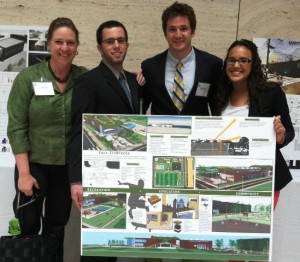A team of Lafayette students placed second in the 2012 Sustainable Design Competition sponsored by the Delaware Valley Green Building Council (DVGBC), successfully competing against teams from graduate school programs.

Mary Wilford-Hunt (left-right), Nicolas Olivares '13, Michael Gadigian '13, and Gabriela Lachapel '12 pose with their second-place project.
Developing the design for a community recreation center were Gabriela Lachapel ’12, who graduated with an A.B. with majors in engineering studies and economics; Katie Reinhardt ’12, who graduated with a B.S. in civil engineering; Michael Gadigian ’13 (Katonah, N.Y.), an engineering studies major; and Nicolas Olivares ’13 (Emmaus, Pa.), a mechanical engineering major.
Each year, students in the Sustainable Solutions course taught by Mary Wilford-Hunt, director of facilities planning and construction, team up to work on submissions for the contest.
The challenge this year was to re-imagine an urban recreation center. Teams were asked to use adaptive reuse strategies and analysis to design their vision of what a recreation center can be for the community. Teams could select one of several centers and facilities in Philadelphia, all in need of repairs and modernization. Lafayette’s team chose the Vare Rec Center and visited it.
“The competition provided an excellent opportunity for students to explore various strategies for achieving heightened project sustainability, including green architectural design, sensitive site development, and effective community connectivity,” Wilford-Hunt says.
The students incorporated several sustainability techniques into their design, dubbed Vare TURFecta:
- taking advantage of natural sunlight for lighting and heating
- providing systems for collecting and storing rainwater for use on nearby fields
- incorporating ground source heat pumps underneath an athletic turf field to help naturally heat and cool the building
- including a walkable green roof, where community members could grow plants.
One feature that drew the judges’ attention was a glass-walled exposed mechanical room inside the main lobby.
“This gave the community and users of the recreation center the opportunity to understand how the building really worked and learn about their energy usage,” explains Lachapel.
The project brought together students from different disciplines of engineering. Because each came to the project with different specializations, they also had different visions of what the end result should look like, which meant looking for common ground and finding compromises.
“My biggest take away was learning how to appreciate everybody’s individual contributions on a team project,” Lachapel says. “In the grand scheme of things, architects, civil engineers, mechanical engineers, contractors and others all have to work together to produce one product. For us, we had to worry about meeting the criteria and pleasing the judges while considering building materials, theme, community outreach, education, and much more, so we knew each of us would have a different opinion with regard to the various aspects of the project.”
Wilford-Hunt tapped into her network of industry connections to give the students opportunities to meet with and learn from working professionals, including representatives from three architectural firms and a civil engineering firm, a mechanical engineer, and a marketing consultant.
Gadigian says he learned a lot about new technologies that make buildings more efficient and use less energy.
“These skills will definitely be useful in the real world, as most buildings will be incorporating these technologies in the near future,” he says. “I would like to someday be LEED [Leadership in Energy and Environmental Design] accredited and build sustainable houses or buildings using some of these same technologies that we incorporated into our project.”

2 Comments
Well Done! Congratulations to the team!
Comments are closed.